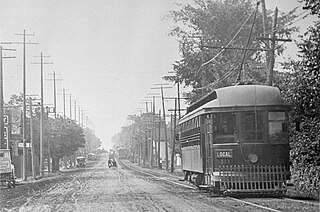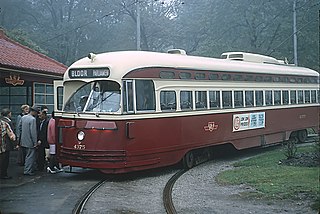
A Birney or Birney Safety Car is a type of streetcar that was manufactured in the United States in the 1910s and 1920s. The design was small and light and was intended to be an economical means of providing frequent service at a lower infrastructure and labor cost than conventional streetcars. Production of Birney cars lasted from 1915 until 1930, and more than 6,000 of the original, single-truck version were built. Several different manufacturers built Birney cars. The design was "the first mass-produced standard streetcar " in North America.

The Toronto Railway Company (TRC) was the operator of the streetcar system in Toronto between 1891 and 1921. It electrified the horsecar system it inherited from the Toronto Street Railway, the previous operator of streetcar service in Toronto. The TRC was also a manufacturer of streetcars and rail work vehicles, a few of which were built for other streetcar and radial operators.

Toronto Civic Railways (TCR) was a streetcar operator created and owned by the City of Toronto, Ontario, Canada, to serve newly annexed areas of the city that the private operator Toronto Railway Company refused to serve. When the Toronto Railway Company's franchise expired in 1921, its services were combined with those of the Toronto Civic Railways, and are now assumed by the new Toronto Transportation Commission (TTC). The first route of the TCR started operation on December 18, 1912.

The Metropolitan line in the Toronto area, operated by the Metropolitan Street Railway, started out as a local horsecar line and transformed itself into an electric radial line extending to Lake Simcoe, following an old stage coach route. In 1904, the railway was acquired by the Toronto and York Radial Railway (T&YRR) and became the T&YRR Metropolitan Division. In 1922, the City of Toronto acquired the T&YRR and contracted Ontario Hydro to manage the four T&YRR lines including the Metropolitan. In 1927, the TTC took over the operation of the Metropolitan Line to Sutton, and renamed it the Lake Simcoe line. In 1930, the TTC closed the Metropolitan Line but shortly reopened the portion between Glen Echo and Richmond Hill operating it as the North Yonge Railways until 1948.

Toronto Transportation Commission (TTC) was the public transit operator in Toronto, Ontario, Canada, beginning in 1921. It operated buses, streetcars and the island ferries. The system was renamed the Toronto Transit Commission (TTC) in 1954.

The Toronto streetcar system is a network of eleven streetcar routes in Toronto, Ontario, Canada, operated by the Toronto Transit Commission (TTC). It is the third busiest light-rail system in North America. The network is concentrated primarily in Downtown Toronto and in proximity to the city's waterfront. Much of the streetcar route network dates from the second half of the 19th century. Three streetcar routes operate in their own right-of-way, one in a partial right-of-way, and six operate on street trackage shared with vehicular traffic with streetcars stopping on demand at frequent stops like buses. Since 2019, the network has used low-floor streetcars, making it fully accessible.

The history of public transportation in Toronto in Canada dates back to the middle 19th century under many different private companies, organizations and owners, which were all later unified as a single government-run entity during the 1920s.

The Preston Car Company was a Canadian manufacturer of streetcars and other railway equipment, founded in 1908. The company was located in the town of Preston, Ontario. Preston sold streetcars to local transport operators including the Grand River Railway, the Toronto Railway Company and Toronto Civic Railways, and the Hamilton Street Railway. The company also sold a number of its distinctive ‘Prairie-style’ cars to operators in Alberta and Saskatchewan; one of these cars is being restored by the Saskatchewan Railway Museum. The Edmonton Radial Railway received 8 "Prairie" Prestons in 1909 and 1911 and 35 "Big" Prestons in 1913–14. Only a few Preston-built cars now remain, some of them in the collection of the Halton County Radial Railway museum. The Edmonton Radial Railway Society has in its collection "Prairie" Preston car 31 and "Big" Prestons numbers 53, 65 and 73.

Hawker Siddeley Canada was the Canadian unit of the Hawker Siddeley Group of the United Kingdom and manufactured railcars, subway cars, streetcars, aircraft engines and ships from the 1960s to 1980s.

The Toronto version of the Peter Witt streetcar was designed by Peter Witt, a commissioner of the Cleveland Street Railway in the United States. Between 1921 and 1923, the Toronto Transportation Commission ordered a total of 350 Peter Witt motor cars. 225 trailers would be ordered from three companies in Canada: Canada Car and Foundry of Montreal, Ottawa Car Company and Preston Car Company (Brill). The cars were designed for riders to "pay as you enter", and initially used two-person operation.

506 Carlton is a Toronto streetcar route run by the Toronto Transit Commission in Ontario, Canada. It runs from Main Street station on subway Line 2 Bloor–Danforth along Gerrard, Carlton and College Streets to High Park. Despite the route's name, less than 10 percent of its length actually uses Carlton Street.

In 1921, the Toronto Transportation Commission (TTC) was created to integrate and operate the Toronto streetcar system. The system has had numerous different rolling stock throughout its history.

Jane Loop was an important Toronto Transit Commission (TTC) streetcar turning loop and bus station, prior to the completion of the Bloor Danforth Subway line. The Jane Loop opened on December 31, 1923; it was the western end of Bloor Streetcar line from 1925 to 1968. The loop was at a boundary between two zones in the TTC's zoned fare system. Half a dozen or so buses and trolleybuses terminated at the loop.

The Toronto Transit Commission operated the Bloor streetcar line along Bloor Street and Danforth Avenue, extending at its longest from Jane Street in the west end of the city to Luttrell Avenue in the east. Both Luttrell and Jane loops at the termini were transfer points between streetcars and suburban bus routes. The line was abandoned in 1966 with the opening of the Bloor-Danforth subway line, except for two stubs of the line abandoned in 1968.

The Toronto Transit Commission's Luttrell Loop was the eastern terminus of the Bloor streetcar line. The loop was closed in 1968 after completion of an extension of the Bloor–Danforth subway line.

Public transportation in the Canadian city of Toronto dates back to 1849 with the creation of a horse-drawn stagecoach company. Today, Toronto's mass transit is primarily made up of a system of subways, buses, and streetcars, covering approximately 1,200 km (750 mi) of routes operated by the Toronto Transit Commission (TTC) and inter-regional commuter rail and bus service provided by GO Transit.

Various organizations operated streetcars on Parliament Street, in Toronto, Ontario. The Toronto Transit Commission (TTC) discontinued scheduled service on Parliament in 1966, when it opened the Bloor-Danforth subway.

The Harbord streetcar line was an east-west line within the Toronto streetcar system. The route was named after Harbord Street even though only a small portion of the route was along the namesake street. One distinct characteristic of the route was its zip-zag nature, making many 90-degree turns onto the various streets along its route. The route was retired in 1966 when the Toronto Transit Commission (TTC) opened the Bloor–Danforth subway line, the city's first east-west subway line.

Toronto-gauge railways are tram and rapid transit lines built to Toronto gauge, a broad gauge of 4 ft 10+7⁄8 in. This is 2+3⁄8 in (60 mm) wider than standard gauge of 4 ft 8+1⁄2 in which is by far the most common track gauge in Canada. The gauge is unique to the Greater Toronto Area and is currently used on the Toronto streetcar system and the Toronto subway, both operated by the Toronto Transit Commission. Several now-defunct interurban rail systems also once used this gauge. The Halton County Radial Railway, a transport museum is located on one of the former interurban lines and uses the Toronto gauge.

The St. Clair Carhouse was a streetcar facility in Toronto, Ontario, Canada. It was located south of St. Clair Avenue on a parcel of land bounded by Wychwood Avenue on the east, Benson Avenue on its north side and Christie Street on the west side. It was opened by the Toronto Civic Railways in 1913, taken over by the Toronto Transportation Commission in 1921 and closed by its successor, the Toronto Transit Commission, in 1998. The carhouse was subsequently transformed into a community centre called the Wychwood Barns.



















